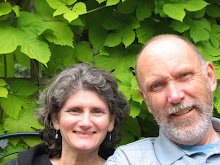Greg and Linda are friends of long standing besides being relatives, and we two, as couples, enjoy many of the same outdoor adventures. Greg and Linda have done a year long camping trip around the US, and their venerable VW camping van with the pop top attracted attention whenever we went somewhere together. And we went quite a few places. Wildlife adventures were absolutely the theme of our times together. Florida is a birder's paradise in the winter, and we took as much advantage as we could.

 We started out on Honeymoon Island where we saw as many osprey as we could shake a stick at. We stopped off at a Florida Power and Light lagoon where manatees gather and saw quite a few of those. And a wander in a park near their house yielded a mangrove cuckoo, an unusual bird in the winter. Bald eagle nests were found here and there, but those eagles are much more common in our own Pacific Northwest, and we didn't find them as exciting as the locals did. A wander on the local beach brought us a sighting of the black skimmer, a with its dramatic bill that is used to skim small fish out of the water as it flies along the surface.
We started out on Honeymoon Island where we saw as many osprey as we could shake a stick at. We stopped off at a Florida Power and Light lagoon where manatees gather and saw quite a few of those. And a wander in a park near their house yielded a mangrove cuckoo, an unusual bird in the winter. Bald eagle nests were found here and there, but those eagles are much more common in our own Pacific Northwest, and we didn't find them as exciting as the locals did. A wander on the local beach brought us a sighting of the black skimmer, a with its dramatic bill that is used to skim small fish out of the water as it flies along the surface. 
 There were so many tropical water birds that are very common in Florida yet rarely seen elsewhere, that we were in birder heaven. There were ibis, egrets, pelicans, storks and herons wherever there was water, and in Florida, water is pretty much everywhere. And then there were the more exotic critters, like the roseate spoonbill, the anhinga, or the painted bunting. We snapped so many photos of water birds that we cannot possibly use them all, but the behavior and habits of these critters are fascinating, and we enjoyed them thoroughly.
There were so many tropical water birds that are very common in Florida yet rarely seen elsewhere, that we were in birder heaven. There were ibis, egrets, pelicans, storks and herons wherever there was water, and in Florida, water is pretty much everywhere. And then there were the more exotic critters, like the roseate spoonbill, the anhinga, or the painted bunting. We snapped so many photos of water birds that we cannot possibly use them all, but the behavior and habits of these critters are fascinating, and we enjoyed them thoroughly.Greg and Linda were preparing themselves for a six week trip to Australia beginning on February 1st, so they had lots to do as well. But we managed to schedule a joint trip to the Everglades National Park at the very southern tip of the Florida peninsula. Unfortunately, my old reliable Canon camera finally gave up the ghost just a couple of days before we left for the Everglades. So although we could use our cell phone for some photos, most of our adventures went unrecorded. I ordered a new Nikon before I left, but it would only arrive on our return, so we were restricted to our ever-diminishing memories to record our adventures.
On our way to the Everglades, we stopped for a few days with Linda's parents, who have a winter home on Pine Island, near Sanibel. Their property is waterfront, and they have a boat that they use regularly for crabbing and just gadding about. We were able to take a day trip to Sanibel Island on the boat for some serious shell-searching, and the next day Linda's dad treated us to a home-built crab feed, which we thoroughly enjoyed.
 At the Everglades, we enjoyed birding, kayaking and hiking for several days. Greg and Linda have their own kayaks, and we rented a double to keep them company. We paddled through ponds and mangrove tunnels and down a canal where manatees kept us company for a bit.
At the Everglades, we enjoyed birding, kayaking and hiking for several days. Greg and Linda have their own kayaks, and we rented a double to keep them company. We paddled through ponds and mangrove tunnels and down a canal where manatees kept us company for a bit. Upon our return, we joined our friends John and Mary, who had joined us previously in Glacier National Park. They were down in Florida for a visit, so we took advantage of a gap in their schedule to join them for tours of Sanibel and Captiva Islands, where shells are legendary. We spent lots of time picking up little treasures along the beach and had some very nice meals in local restaurants as well. Another highlight was a tour of the "Ding" Darling National Preserve, a magnificent park with even more top quality birding.
Another great stop was the Myakka State Park, which included the "canopy walk," high up in the canopy of the forest of live oaks, palms,etc. You got the sensation of what it looks like, perhaps, being a bird soaring over the terrain.
At the end of their visit, we completed our preparations and launched our official return trip. The map of our planned route is contained in this blog on a separate page. We expect to spend the spring along the Texas border and in the Southwest, returning to Seattle around the fourth of July.






No comments:
Post a Comment